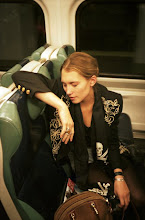Pollock ( I do recommend going to this website - make your own Pollock!)
Whatever names used, Action Painters, American Type Painters, The New York School, Abstract Expressionists, there is no doubt that this movement altered the direction of modern art, making the MoMA’s showcase a perfect fit. Floors two, three, and four hold the works of artists who were either directly or indirectly involved with the movement, which spanned mainly from the late 1940’s to the early 1950’s.
There is an overwhelming sense of national pride in this show, and with its bold title, a sense of local pride. These artists put America on the map. Until this breakthrough only European artists, dripping with fresh, Cubist paint, were being shown in New York galleries and museums.
Abstract Expressionist New York reminds us of that pinnacle time in the art world when an artistic manifestation of freedom of speech was expressed. This movement of revolt stemmed from artists finding inspiration internally, thus visually expressing themselves in an unconventional manner.
The MoMA makes us step back from all preconceived notions of Abstract Expressionism. The grandiose formal and contextual techniques of the movement are already known, and have been regurgitated over and over again, but this exhibit showcases the inevitable impact these works have on their viewers.
What have the Abstract Expressionists done to us? These artists are prolifically exhibited, and MoMA’s exhibit brings them together like a high school reunion. The exhibit essentially allows viewers to reevaluate Abstract Expressionism, because we needed to forget to appreciate - believe to see them again.
People stand in wonderment, as if waiting for a painting to say something, give a clue. The latter could be the hand prints of Pollock that appear in the upper right corner of Number 1A, 1948 [1948], which one woman pointed out all too well. Her observation made the crowd buzz and tentatively inch closer.
But not all Abstract Expressionists dripped paint onto their canvases, there are various subdivisions of the movement, the two most prominent being color field and gestural. The former including Mark Rothko, Barnett Newman, and Clyfford Still, and the latter; Hans Hoffman, Pollock, and de Kooning.
This exhibit maps the evolution of Abstract Expressionism. By walking through each gallery and then up another flight of stairs, viewers are physically and mentally climbing through an artistic matrix. Through this aesthetic journey, viewers are gradually able to encompass the spirit of the artists, which was expressing a more personal vision of contemporary culture.
Viewers leave this exhibit dripping with hazy blocks of color spinning through their minds. The MoMA’s overachieving attempt to display the passion of this movement is thoroughly understood. The exhibit displays a deluge of works to stress the power of Abstract Expressionists.
For these artists, to believe was to see. They stretched aesthetic boundaries and “broke the ice”(quoting how Willem de Kooning once described Jackson Pollock’s work).
In time, one must visit and revisit the exhibit, and follow the artists’ understanding that believing is seeing. Their work is product of their beliefs. To digest the work is to trust it, and through this submerged relationship, viewers are able to see the meaning behind Abstract Expressionist New York.
Rothko
Newman














No comments:
Post a Comment